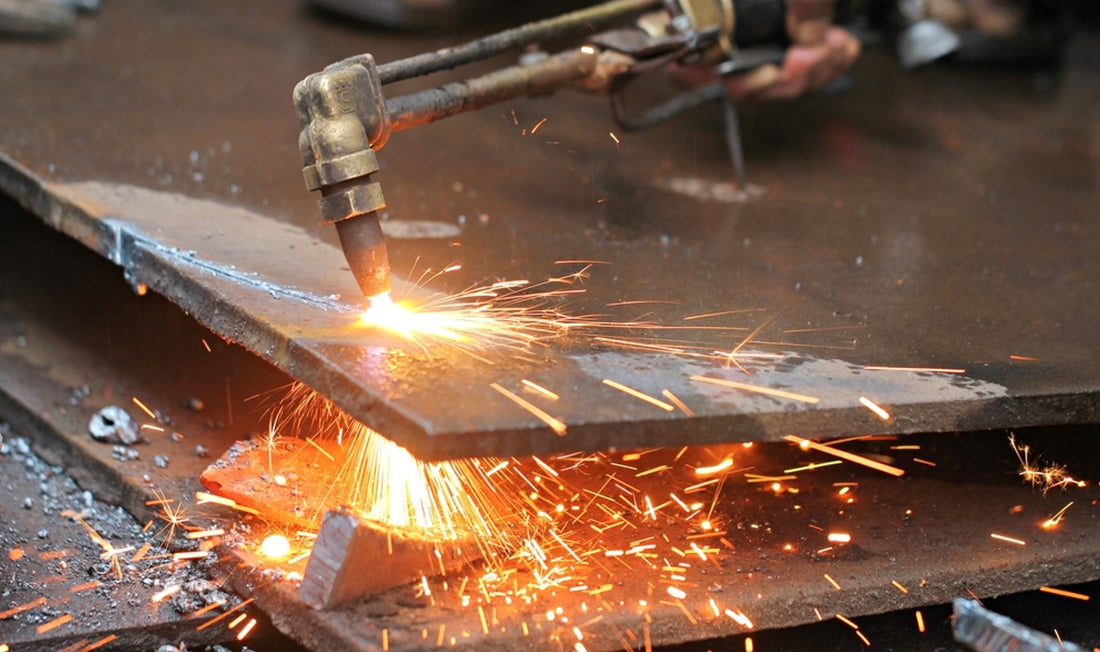Are you planning your next metal project but can’t decide whether you should grab a cutting torch or plasma cutter to slice your way through the tough materials? If so, this article is for you.
In the text below, you will find plenty of information discussing what metal cutters are and which tasks they are best suited for tackling. Once you reach the end, you should clearly understand which option is right for you.
What Is a Cutting Torch?

When you think of torches today, there is a high chance you picture a cutting torch. This is the most common torch used today for various projects, with one of those tasks being metal cutting.
A cutting torch uses a flame that reaches a very high degree of temperature and melts metal before being cut. While this is an effective way of cutting this type of material, it can take longer to complete any task and isn’t as accurate or clean as other methods.
Because a cutting torch gets so hot, there is a greater likelihood of burn marks, discoloration, and possible warping.
You can use a few different types of fuel with cutting torches, including:
- Acetylene (most common)
- Propane
- Propylene
- HGX propane
Your choice is ultimately based on availability, your cutting needs, and your budget.
What Is a Plasma Cutter?

A plasma cutter is often used in metal cutting thanks to its impeccable precision and lower levels of heat required for a clean cut. A few gasses are compatible with a plasma cutter, and the best option depends on the material you are trying to cut through.
A plasma cutter uses a stream of very hot ionized gas at a high velocity, thus slicing through metal materials like aluminum and steel.
On the downside, the plasma cutting process is more expensive than torch cutting and may not be an affordable option for everyone.
Pros and Cons of a Plasma Cutter and Cutting Torch
Each cutting tool can be a great option depending on the job you are preparing to tackle and the materials involved. However, both of them also come with their own list of cons that can make their opponent seem like the better fit.
Pros and Cons of a Plasma Cutter
Here is a list of the pros and cons of using a plasma cutter.
Pros:
- Cuts through a wide range of materials and metals
- Offers a quicker cutting speed than other cutting tools
- Short learning curve and easy to use
- High-quality hole
- Creates a smoother, more precise cut than other options
Cons:
- Can produce a large area of heat-affected zones due to the high heat required to cut through metal material
- More expensive than cutting torches
- Produces toxic fumes that can be harmful to your health
- Can potentially create microfractures in some types of materials
Pros and Cons of a Cutting Torch
Here is a list of the pros and cons of using a cutting torch.
Pros:
- Faster when cutting thick metal (eg. cutting through 6+ inches of thicker metal)
- More versatile than a plasma torch because they do not require an electrical source to create heat
- More affordable than most plasma cutting
- Can use a cutting torch on most metals since an electrical arc is not used to create the heat
Cons:
- Requires longer warm-up times to reach optimal temperatures
- Extremely high heat can quickly lead to the warping of the metal
- Not as precise or clean as a conventional plasma cutter
- Can’t cut through aluminum or stainless steel
Which Cutting Tool Is Right For You: Plasma Cutter or Cutting Torch?

When it comes right down to it, both the plasma cutter and the cutting torch offer benefits to those using them during metal fabrication. The type of tool you select should be based on your desired outcome.
If you are a DIYer looking to create a quick metal project using thicker materials but are not worried about a few discoloration spots or uneven cuts, the cutting torch will be your best bet.
On the other hand, if you want to tackle a project that requires a higher level of precision with fewer blemishes or chances of warping, you will want to choose a plasma cutter.
Although a plasma cutting system is the more common choice when slicing through metal objects, you can use a cutting torch to get similar results in smaller jobs.
Side By Side Comparison
Let's take a quick look at both options for an easier time differentiating between a plasma cutter and a cutting torch.
|
Plasma Cutter |
Cutting Torch |
|
Uses a stream of hot ionized gas to cut |
Uses extreme temperatures of heat created by various gasses |
|
Requires an electric power source |
Uses a gas can or tank so it’s portable |
|
Plasma cutting is quicker for most metals |
Cutting torches can take time to heat up and make cuts, warping the metal |
|
Easy to set up and use |
Takes some time to learn how to control the flame and heat setting |
|
More expensive |
Affordable |
|
Creates a cleaner, smoother edge |
Not as precise as the plasma cutter |
|
Better for detailed, professional projects |
Ideal for DIY projects |
Our Conclusion
You really can’t go wrong when using either of these cutters on your upcoming metal project. Both of the options possess similar numbers of pros and cons, meaning each is equally useful. The only difference between the two is the projects they are best suited for.
Before choosing a cutting torch or plasma cutter for your next metal project, look at the article above to make an informed decision that will produce the most successful outcome.

